Chippenham, Wiltshire: Difference between revisions
Created page with '{{Infobox town |name=Chippenham |county=Wiltshire |picture=ChippenhamButtercross.jpg |picture caption=Chippenham Buttercross |os grid ref=ST919733 |latitude=51.4585 |longitude=-2…' |
m Owain moved page Chippenham to Chippenham, Wiltshire |
(No difference)
| |
Latest revision as of 12:38, 14 October 2014
| Chippenham | |
| Wiltshire | |
|---|---|
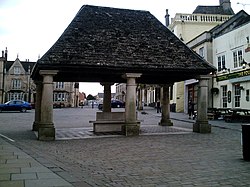 Chippenham Buttercross | |
| Location | |
| Grid reference: | ST919733 |
| Location: | 51°27’31"N, 2°6’57"W |
| Data | |
| Population: | 28,065 (2001) |
| Post town: | Chippenham |
| Postcode: | SN14, SN15 |
| Dialling code: | 01249 |
| Local Government | |
| Council: | Wiltshire |
| Parliamentary constituency: |
Chippenham |
Chippenham is a market town in Wiltshire, found 13 miles east of Bath. In the 2001 census the population of the town was recorded as 28,065.
The town was established on a crossing of the River Avon and is believed to have existed as some form of settlement since before Roman times. It was a royal vill, and probably a royal hunting lodge,[1] under Alfred the Great. Kings lodge school, a primary school in Chippenham was named after King Alfred's Hunting lodge. The town continued to grow when the Great Western Railway arrived in 1841, and while historically a market town the economy has changed to that of a commuter town.
Name of the town
The Anglo-Saxon Chronicle records the town as Cippanhamm, which would be pronounced much as the town's name is pronounced today. The name may refer to a founding landowner ("Cippa's meadow") or it may be derived from the Old English word Ceap, meaning market.[2][3]
The name is recorded variously as Cippanhamm (878), Cepen (1042), Cheppeham (1155), Chippenham (1227), Shippenham (1319) and Chippyngham (1541).[4] On John Speed's map of Wiltshire (1611), the name is spelt both Chippenham (for the hundred) and Chipnam (for the town itself).
Two villages share the name: Chippenham, Cambridgeshire and Chippenham, Monmouthshire. There is also a Cippenham in Buckinghamshire.
The lie of the land
Chippenham is set on a prominent crossing of the River Avon and lies between the Marlborough Downs to the east, the Cotswolds to the north and west and Salisbury Plain to the south.
The town is surrounded by sparse countryside and there are several woodlands in or in close proximity to the town, for example, Bird's Marsh, Vincients Wood and Briars Wood.
Chippenham railway station is on the main line rail route and an important junction between London Paddington to the West Country and is famous for its railway arches and other buildings engineered by Isambard Kingdom Brunel as part of the Great Western Railway development. It is served by main line services and a smaller service towards Southampton.
Sights of the town
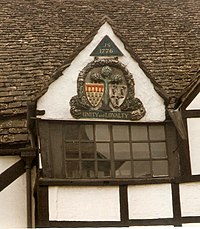
The original Buttercross, a stone structure, was erected in c. 1570 and stood in the current location of Barclays Bank, where it served as the centre of the Shambles. The Buttercross was used for the sale of meat and dairy produce.
In 1889 Mr E C Lowndes bought the Buttercross for £6. He re-erected it as a gazebo in the kitchen garden of the Castle Combe Manor House, where it subsequently fell into disrepair. The Buttercross was re-erected in 1995 by the Chippenham Civic Society with funding provided by a wide range of local individuals and organisations. It currently stands as the centre-piece of the pedestrianised area of the town centre, where a market is held each Friday and Saturday.[5]
The Yelde Hall is currently the site of the Tourist Information Centre in Chippenham. It is run jointly by Chippenham Town and North Wiltshire District Councils and is the largest Tourist Information Centre in North Wiltshire. The hall is one of very few remaining mediæval timber framed buildings in the town. It was originally divided up internally for use as a market hall. Both the hall and its meeting room upstairs were used by the burgess and bailiff for a variety of meetings and trials as well as being used for Council meetings. The space under the Council Chamber was used as the town gaol. The hall was also used in this time for fund raising events for the local church. After the Council and Burgess (now Mayor) moved to the Town Hall (High Street, Chippenham) in 1841 the hall had many different uses:
- Chippenham Savings Bank
- Chippenham Volunteer Rifle Corps (stationed in Chippenham from 1846 to 1911)
- Chippenham Fire Station (from around 1910 until 1945 when they moved to their current location in Dallas Road) this led to substantial changes to the interior structure to accommodate the engines and the addition of two large doors to the end gable
- Chippenham Museum (the Borough Council started work on this in the 1950s but the museum didn't open until 25 October 1963. The museum outgrew the site and closed in this location in 1999)
- Tourist Information Centre (since March 2003 following substantial restorations)[6]
Bird's Marsh
Bird's Marsh is a large woodland to the north of the town. It is home to many kinds of wildlife, and a popular place for walkers, due to its fairly large size and surrounding countryside. One entrance into Bird's Marsh can be found through a field close to the supermarket, just south of the roundabout on the A350 Malmesbury Road. There are also access points off Hill Corner Road (over fields) and Jacksom's Lane.
Although not actually a marsh these days, the ground can be very boggy off the well-marked paths, a feature which has protected this area from housing development.
In 2008, developers made a planning enquiry about building 800 homes around the Bird's Marsh area.[7][8]
History
There are believed to have been settlements in the Chippenham region since before Roman times. Remains of Romano-British settlements are visible in the wall behind the former Magistrates' Court|magistrates court and recent redevelopments of the town have shown up other evidence of the earliest settlements.[9]
Early Mediæval
In 853, Æthelswith, sister to Alfred the Great, married King Burgred of the Mercians in Chippenham. Alfred was then a boy of four and the wedding is believed to have been held on the site of St Andrew's church. According to Bishop Asser's Life of King Alfred Chippenham was, under Alfred's reign, a royal vill;[10] historians have also argued, from its proximity to the royal forests at Melksham and Barden, that it was probably a hunting lodge.[1] Alfred's daughter was also married in Chippenham.[11]
Chippenham was successfully besieged by Danish Vikings in 878, though Alfred escaped. Later that year Alfred decisively defeated the Danes at the Battle of Ethandun, whose forces then surrendered to Alfred at Chippenham.
In 1042 the Royal holding in Chippenham makes mention of a church.[3]
The Domesday Book lists Chippenham as Cepen, with a population of 600-700 people in 1086.
High and Late Mediæval
In Norman times the Royal properties were separated into the manors of Cheldon, Rowden and Lowden. Records show that the town expanded into Langstret (now the Causeway) from 1245 onwards and in 1406 onwards the town pushed into Le Newstret (now the New Road) area of town. Throughout this period Chippenham continued to have a thriving market in the town centre.
The A4 that runs through Chippenham (from London to Bristol) incorporates parts of the 14th century mediæval road network that linked London to Bristol through Chippenham. This was an important road for the English cloth trade and its upkeep was funded in part by cloth merchants from Bristol due to its importance to the trade.[11]
Chippenham was a borough electing two members to Parliament from 1295 onwards and Queen Mary I granted the town a Charter of Incorporation in 1554.
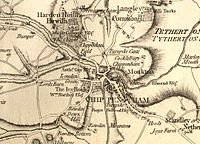
Analysis of the wood used to build the Yelde Hall indicates that the market hall was built after 1458. The Shambles and Buttercross were built after 1570.[9] The Shambles were destroyed in a fire in 1856 and the Yelde Hall survived.[12]
The parish of Chippenham Without encompasses the deserted mediæval village of Sheldon, devastated by plague; all that remains today is Sheldon Manor, Wiltshire's oldest inhabited manor house, dating from 1282.
16th to 18th centuries
The wool industry took off in the 16th century due, in part, to the river. The plague hit the town hard in 1611 and 1636. This, a recession in the woollen industry, and a drop in corn harvests in 1622 and 1623, caused massive hardship for the town's population. The trade in cloth faced further problems during the English Civil War due to a Royalist proclamation that prohibited the sale of cloth to the Parliamentarian controlled London.
In 1747 a bribery and corruption scandal (involving two members of parliament for Chippenham) led to the downfall of Sir Robert Walpole's government.
19th and 20th centuries

A spur off the Wilts & Berks Canal was built to Chippenham in 1798 with a wharf at the current site of the bus station (Timber Street) with the main commodity traded being coal. Pewsham Way now follows the line of the old canal. The Great Western Railway arrived in Chippenham in 1841 which in turn attracted many new businesses to Chippenham. The arrival of these businesses required new housing which led to the expansion of Chippenham into the land north of the railway line, which in turn led to the growth of further industries to support the building work.
The arrival of the railway promoted the growth of industrial agricultural businesses. In the middle of the 19th century Chippenham was a major centre for the dairy and pork produce; this led, later, to Nestle and Matteson's to have factories in the town centre. The railway also led to the growth of railway engineering works in Chippenham. The first of these was Roland Brotherhood in 1842. A variety of companies then took over part or all of the business on the site until in 1935 Westinghouse Brake and Signal Company Ltd took over the business site fully. [9] The signalling side of the business remains at the Chippenham site and is now owned by Invensys Rail Group; the brakes business was taken over by the German company Knorr-Bremse [13], and is based at a site in nearby Melksham.
On 13 February 1998, two unexploded bombs from Second World War were discovered in the field behind Hardens Mead during preparations for the building of Abbeyfield School. About 1,100 residents living in the east of Chippenham had to be evacuated for two nights to friends and relatives or emergency accommodation until the Army carried out a controlled explosion.[12] The Army initially attempted to defuse the larger device but it was decided that owing to the bomb's orientation in the ground it would be too dangerous.[14]
Churches
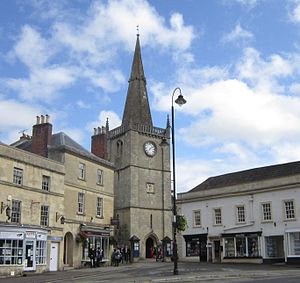
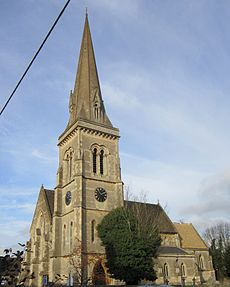
Parish church
- St Andrew's Chippenham, the parish church, is believed to have been built on the site of an Anglo Saxon church. Many features of the present church are Norman. The chancel arch was completed in c.1120. There are a wide variety of features on the different facets of the church. The church spire was completed in 1633 although the 8 bells currently present were not added until 1734 and the back-lit clock and chimes in 1858. The organ has a case front dating from the 18th century. The church registers date from 1578.
There was a Victorian era restoration of the interior of the church in 1875 - 1878 and another restoration in the 1990s.
Other churches
- Church of England:
- St Andrew's
- St. Nicholas church, built in 1779 and replaced an older mediæval church that had previously stood on the same site
- St. Paul's church, built in 1854/5
- St. Peter's, built in 1968 with a fibreglass spire, replacing an earlier church consecrated in 1886
- Baptist:
- The Old Baptist Chapel opened on 10 June 1804 but only registered in 1810
- Station Hill Baptist Chapel
- Independent evangelical:
- Chippenham Christian Fellowship
- Dayspring Church for North Wiltshire
- Emmanuel Evangelical Church
- Ladyfield Evangelical Church
- Oasis Church
- Methodist:
- Central Methodist Church, built in 1909 to mark the centenary of Methodism in Chippenham
- Sheldon Road Methodist Church
- Pentecostal:
- Ascension Church (Assemblies of God)
- Elim Pentecostal Church
- Religious Society of Friends (Quakers)
- Salvation Army Citadel
- United Reformed Church: Tabernacle URC, built in 1770 but replaced in 1826
- Roman Catholic: St Mary's
Closed churches
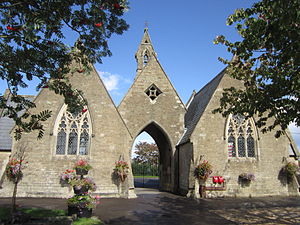
- Cepen Park Methodist church held services in two local schools and closed in 2005.
- Causeway Methodist Chapel opened in 1896 replacing an older chapel on the same site. The older chapel is believed to have been built in around 1835 and still stands to the rear of the newer building (and served as a school room for it). It closed in the late 1980s although the buildings remain.
Culture
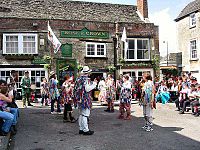
The Chippenham Folk Festival[15] takes place every year, usually over the Whitsuntide weekend.
The town holds an annual festival to mark the death of singer Eddie Cochran, who died on 17 April 1960 following a car crash in Chippenham.
From 25 October 1963 until 1999, the Town Museum was housed in Yelde Hall. The museum had, by this time, outgrown the site and moved to the former Magistrates' Court in the Market Place (opening on 23 March 2000). The museum charts the history of the town from Neolithic times until today. By 2005, the museum had attracted over 90,000 visitors.[6]
Economy
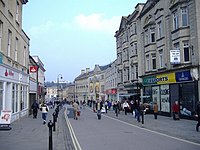
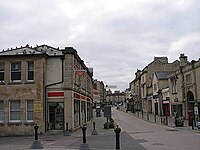
Historically a market town, Chippenham's economy has since changed to that of a commuter town with residents travelling to workplaces in Bath, Bristol, Swindon and London.
Several large businesses have been located in the region, with the biggest former employer being Westinghouse, now owned by Invensys, whose factory complex lies next to the railway station. The company undertakes railway signalling contracts for Network Rail, London Underground as well as railway operators is other parts of the world. Parts of the Westinghouse site are occupied by a range of companies.
A number of other industrial sites lie around the town, Bumpers Farm being the largest, home to many businesses of all sizes.
In 2005, Europe's second largest logistics organisation, Wincanton PLC, consolidated its head office operations and moved to the newly developed Methuen Park office development in west Chippenham, where it employs around 350 people.
Shopping
Chippenham's major retail area surrounds the pedestrianised High Street and Market Place, which consists of numerous shops of various categories. Two shopping centres lie on either side of the High Street; the enclosed Emery Gate Shopping Centre and the open air Borough Parade Shopping Centre.
Of all the shops in the High Street and nearby alleys there are very few independent stores as franchises dominate, however some independent stores (Jewellers, Nail Bars, Florists, Bridal Gowns, Hairdressers) are located along The Causeway and the Upper Market Place.
Retail parks, such as the Hathaway Retail Park, are located on the edge of town containing larger superstores and fast-food outlets.
Market
Chippenham is a market town, with street markets taking place most Fridays and Saturdays around Market Place and along the pedestrianised High Street. A Farmers' Market for the sale of fresh, locally produced foodstuffs is also held here once a fortnight.[16] The original Cattle Market, which closed in 2004, is now being redeveloped by Linden Homes Western Limited as one of the UK's largest eco-housing projects.
Tourism
Surrounding the town are a number of stone-built villages, including Lacock (National Trust), Biddestone, Bremhill and Castle Combe.
The great house and art treasures of Longleat, Bowood House, Lacock Abbey, Sheldon Manor and Corsham Court are within easy reach.
Outside links
| ("Wikimedia Commons" has material about Wiltshire Chippenham, Wiltshire) |
- Chippenham Town Council
- Chippenham on the council tourism website for Wiltshire]
References
- ↑ 1.0 1.1 Wood, Michael (1981). In Search of the Dark Ages. BBC. p. 111. ISBN 0563178353. http://books.google.com/?id=4GafAAAAMAAJ&dq=%22alfred%22chippenham+%22hunting+lodge%22&q=hunting+lodge.
- ↑ Chamberlain, Joseph (1976). Chippenham: Some notes on its history. Chippenham Charter Trustees. pp. 199pp. BRN0066062.
- ↑ 3.0 3.1 Platts, Arnold (1946). The History of Chippenham A.D. 853-1946. Wiltshire Gazette Printing Works. pp. 98pp. BRN0141031.
- ↑ Jefferies, Sally (1987). A Chippenham Collection. Chippenham Civic Society. pp. 107pp. BRN0541107.
- ↑ From the inscription on the Buttercross itself.
- ↑ 6.0 6.1 Chippenham Town Council (1989). King, Emma. ed. Chippenham Town Guide. London: EJ Burrow.
- ↑ "Facebook campaign to save Birds Marsh Wood from development". Western Daily Press. 2 January 2009. http://www.thisisbristol.co.uk/wdp/home/wiltshire/Facebook-campaign-save-Birds-Marsh-Wood-development/article-583017-detail/article.html.
- ↑ "Protesters fight to save Chippenham beauty spot". Gazette and Herald. 1 January 2009. http://www.gazetteandherald.co.uk/news/4011618.Protesters_fight_to_save_Chippenham_beauty_spot/.
- ↑ 9.0 9.1 9.2 "Chippenham's History". About Chippenham. Chippenham Town Council. http://www.chippenham.gov.uk/about/history.htm. Retrieved 2007-02-10.
- ↑ "Antiquarian researches". The Gentleman's Magazine 199: 415. 1855. http://books.google.com/?id=0xcq_Ejp6pEC&pg=PA415&dq=%22alfred%22chippenham+%22hunting+lodge%22.
- ↑ 11.0 11.1 "Chippenham". Wiltshire Council. http://history.wiltshire.gov.uk/community/getcom2.php?id=54. Retrieved 2010-11-10.
- ↑ 12.0 12.1 Eddolls, Trevor. "Chippenham's history". http://www.eddolls.com/chip.htm. Retrieved 2007-02-10.
- ↑ name="Westinghouse Brakes sold to Knorr-Bremse" href="http://www.investegate.co.uk/article.aspx?id=200004251238495290J"
- ↑ "Army to detonate wartime bomb". BBC News. 1998-02-14. http://news.bbc.co.uk/1/hi/uk/56543.stm. Retrieved 2007-02-10.
- ↑ "Chippenham Folk Festival homepage". http://www.chippfolk.co.uk.
- ↑ "Town Market". Chippenham Town Council. Archived from the original on 2007-02-04. http://web.archive.org/web/20070204065120/http://chippenham.gov.uk/about/market.htm. Retrieved 2007-02-11.
